What is the role of artist activism in an increasingly anxious and polarised society in the face of global warming, pandemics and increasing income/wealth inequality and insecurity?
What has inspired art-making through the centuries from the markings on cave walls and ritual dancing and story-telling, to the plethora of images, writings, music and performances that now comprise the world of the creative arts?
People have used the arts to express their love of the world around them, spiritual ideas and ideas about a God, the cosmos and the meaning of life. They have also used art to protest injustice and suffering in the world—both of humans, and of the other creatures with whom we share Planet Earth.
The World Economic Forum has suggested that:
‘Art does not show people what to do, yet engaging with a good work of art can connect you to your senses, body, and mind. It can make the world felt. And this felt feeling may spur thinking, engagement, and even action.’ Artist Activism in Australia as reported in the ABC Online
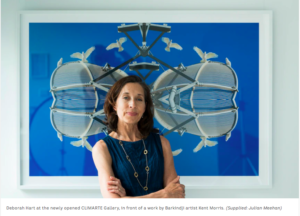
Deborah Hart
Deborah Hart, opened the world’s first gallery in Melbourne devoted to art that responds to the climate emergency: CLIMARTE Gallery
CLIMARTE’s inaugural exhibition, HEAR, honours First Peoples’ deep knowledge of and care for Country and presents the work of Indigenous Australian artists Professor Brian Martin, Kent Morris, Deanne Gilson, James Tylor and Peter Waples-Crowe.
Hartmut Veit
Adelaide-born artist Hartmut Veit and his family lived in mining towns in Papua New Guinea, Germany, Canada and Australia,with his father dying at the age of 62 due to silicosis and lung cancer — the result of a life working in mines.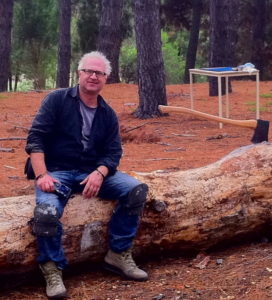
When the Hazelwood mine caught fire in February 2014, burning for 45 days and causing the nation’s worst-ever air pollution event, Veit was already working with Hazelwood’s brown coal dust as an art medium.
Veit has now built his own contemporary eco-art and yoga and meditation space, Stanley Ave Studio, which will open on January 17 in Mt Waverly in Melbourne.
“We all need to reconnect and transform our relationships with self, other and the living world in response to the climate emergency,” he says.
David Hart
David Hart, son of Pro Hart, a well-known artist of outback scenes, has been working on Our Secret War: a book and 50-painting series, created in consultation with Indigenous advisors — including Dr Anita Heiss and the writers and researchers behind Sydney Aboriginal history website Barani.
The paintings will be exhibited in early 2022. Hart is adamant that the arts have a profound role to play in addressing the climate crisis and planning for different kinds of possible futures.
“The impact of the First Fleet on Indigenous Australia has made me think a lot more broadly about how we impact everything we do … the footprints that we make,” Hart says.
“There are big contributors to climate change – the big factories, car manufacturers and coal mines – but we all [have an] impact on everything we do. I don’t drive much, but we still consume things — and it’s impossible not to make a footprint. We’ve got to spin them around so that they count for something positive.”Activist Artists Featured at The Green Hub
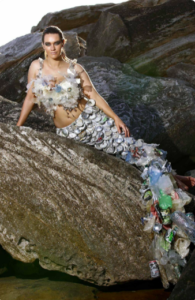
‘Trashion’ Artist Marina Debris
Marina is an Australian artist, growing up by the ocean, and helping on countless beach clean-ups. She soon realised cleaning the beach wasn’t addressing the problem, so began using art to highlight it. She is most famous for creating fashion outfits from ocean pollution. Her pieces are a confronting example of plastic and fashion waste, evoking guilt and action.
‘She encourages the viewer to question the use of single use items, and consider ways to reduce waste so it does not end up in our oceans and landfills.’
Photographer Paul Nicklen
Paul is a Canadian photographer and marine biologist, currently working for National Geographic magazine. His work captures the beauty of nature while documenting wildlife and the effects of climate change. His evoking images show the devastating impacts humanity has had on the planet, from starving polar bears to melting ice caps. His shots are stunning and take a lot of work, from trekking through remote areas to scuba diving under ice.
Realist Artist Zaria Forman
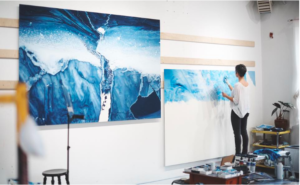
Zaria is an exceptional artist, using pastel to highlight and document climate change and the beauty of nature. Her activist side was inherited from her mother, who used to photograph the most remote areas of the world.
Her work is exhibited worldwide and has been featured in multiple publications from Huffington Post to National Geographic. Her work is incredibly realist, comparable to photographs. Her work is well worth checking out, check out her TED talk here.
Political Street Artist Banksy
The infamous and anonymous ‘vandal’ Banksy, is famous for political street art and adding to an art revolution. Banksy joined a type of art that wasn’t curated and could be seen by everyone, street art. Street art was created in the 1970’s by TEJN in Copenhagen, Denmark. Banksy does not sell or reproduce any art, displaying it randomly on public display on walls.
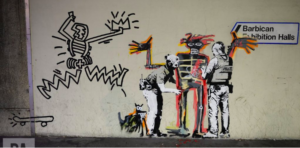 Show me the Monet is a rework of Claude Monet’s Water Lilies, with shopping trollies and a traffic cone in it, showing the destructive nature of mankind on the environment.
Show me the Monet is a rework of Claude Monet’s Water Lilies, with shopping trollies and a traffic cone in it, showing the destructive nature of mankind on the environment.
His work is powerful as it shows the impact one person can have against centralised power. His themes commonly touch on anti-consumerism, anti-fascism and human greed.
Olivia Burton
Olivia is an eco-writer, producer, science graduate & ocean enthusiast. After moving from London to Sydney, she found her love for the outdoors and recycled textiles, which led her to start writing about science and sustainable fashion. Olivia is really passionate about brands using fashion for good and innovation in the industry. She now splits her time between several not-for-profit organisations in communication roles. Olivia is also a Centre for Sustainability Leadership alumni and sits on the Fashion Revolution committee for Australia & New Zealand.Why Artistic Activism
The Centre for Artistic Activism suggests that to change the world we need to imagine what a changed world might look like. They maintain that throughout history the most effective civic actors have married the arts with campaigns for social change, using aesthetic approaches to provide a critical perspective on the world as it is and imagine the world as it could be.
Audre Lorde: “Poetry is the way we help give name to the nameless so it can be thought.”
Art is a means by which to imagine the unimaginable, and artistic activism is the medium that can suggest it as a possibility. Through sound and image and movement, artistic activism can conjure up a vision of what could be in the future and communicate it to others in the here and now. Art gives us the vision. Activism helps us make the road to get there.
Artistic activism has also been a tool used by the most marginalised in society to find their voice and challenge prevailing views and laws. This has been especially true for Australia’s First Nations’ people whose body of artistic production in films, the performing arts, poetry, creative writing, painting, sculpture and multi-media have transformed the Australian artistic landscape both nationally, and internationally.
The Centre for Artistic Activism says that our modern political terrain is a highly mediated landscape of signs and symbols, story and spectacle. To operate successfully on this cultural topography we need to observe, analyse and respond creatively. We need to be Artistic Activists as we make sense of our world through stories and symbols that frame the information we receive and then act accordingly.
Drawing upon creative processes familiar to arts and design, artistic activism encourages blue sky brainstorming, quick sketches, multiple iterations, rapid prototyping, and a spirit of play — as well as risk, and the acceptance of failure. Approached as a creative process, we are more apt to see multiple solutions to problems, and new pathways to attain our objectives. Free to experiment, we may identify and solve problems we didn’t set out to solve, end-running the commonplace framing of politics to open up new possibilities for interpretation and action.

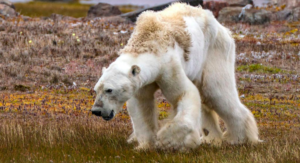
![Call of the Dakini | A Memoir of a Life Lived [Extract]](https://regenesis.org.au/wp-content/uploads/2023/08/Catalogue-OF-Articles-by-Barbara-Lepani-July-2018-July-2023-.jpg)
Recent Comments